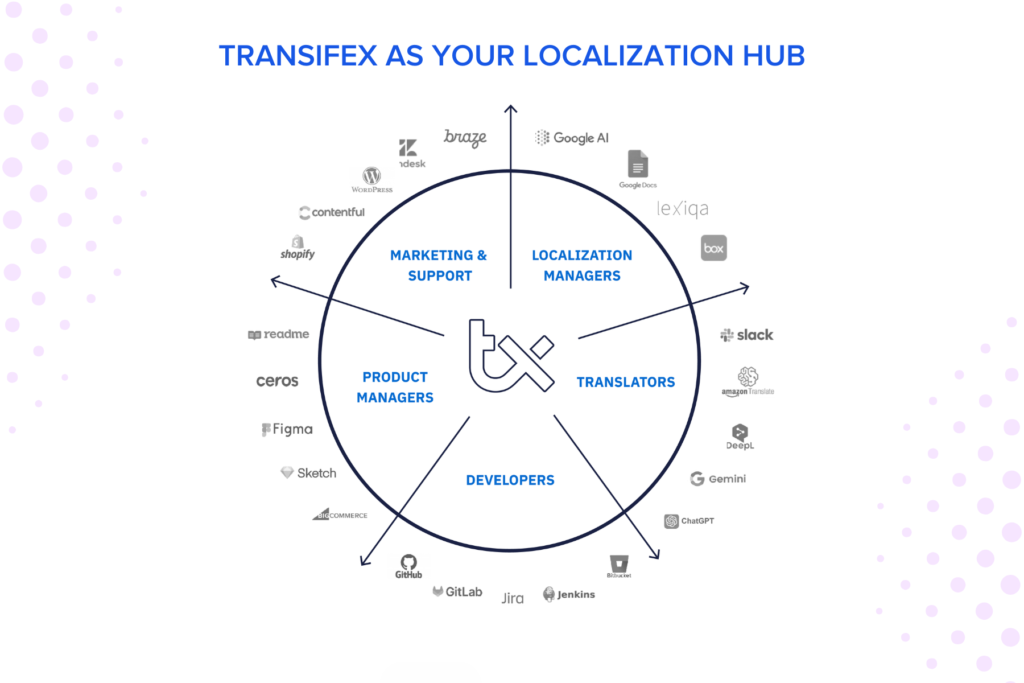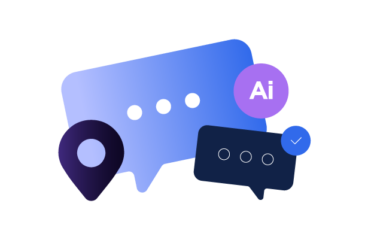For a long time, language barriers have posed a significant challenge to communication among people and organizations. Translating from one language to another has been a time-consuming and often error-prone process that heavily relies on manual tasks and human input.
However, with the emergence of AI and machine learning technologies, we are witnessing a new era in language translation and localization.
In this article, we will delve into these groundbreaking advancements and explore how they are redefining the way we overcome language barriers by facilitating seamless cross-cultural communication and enhancing global business interactions.
What is AI localization?
AI Localization is the integration of artificial intelligence into the localization process, which includes the translation and overall cultural adaptation of different types of content, apps, software, websites, and much more. This technological fusion aims to enhance the efficiency, accuracy, and impact of the localization workflow by leveraging advanced machine learning algorithms and natural language processing (NLP).
Through the use of translation memories, glossaries, and feedback loops, AI systems in localization not only refine translation outputs but also speed up review and project management tasks. The data-driven process underpinning AI allows for the generation of human-quality, contextually appropriate content adaptations at an unprecedented scale.
What roles does Artificial Intelligence play in localization?
AI-driven tools aid in managing localization projects of any scale by automating repetitive tasks, optimizing workflows, and providing predictive analytics for better decision-making.
AI enhances the quality of outputs, reduces time-to-market, and helps maintain consistency across multiple languages and platforms. These capabilities supercharge processes, making them faster, more accurate, and cost-effective, thereby enabling businesses to reach global audiences like never before.
How does AI localization differ from traditional translation?
AI localization differs from traditional translation in several significant ways. Traditionally, human linguists perform the time-consuming task of translating content. AI localization, on the other hand, employs automated systems for handling routine tasks and analyzing large data sets to ensure consistency and provide content recommendations.
While traditional methods depend on the varying skills of individual translators, AI uses historical data and continuous learning to enhance the quality and speed of translations over time. It adapts to feedback and evolving language usage, ensuring that translations remain current and relevant. This innovation does not replace human oversight; instead, it augments human capabilities, making the translation process more efficient.
Here is an overview of the key differences:
Speed and Efficiency: AI accelerates localization by automating time-intensive tasks, unlike traditional methods that rely on slower, manual processes.
Accuracy and Consistency: AI ensures uniform application of terminology across extensive content volumes, a challenge in traditional translation that can suffer from inconsistency when handled by multiple translators.
Cost-Effectiveness: AI reduces reliance on human intervention, cutting costs compared to traditional localization, which incurs higher expenses due to manual project management.
Scalability: Advanced Translation Management Systems (TMS), like Transifex, enable scalable solutions with AI, managing multiple languages and large projects more efficiently than traditional methods, which can become impractical as project sizes increase.
Collaboration and Integration: AI-powered tools enhance global team collaboration and integrate smoothly with other software, streamlining workflows in ways traditional methods cannot.
AI VS Machine Translation Workflows
| Feature | Machine Translation (MT) | AI Localization |
|---|---|---|
| Definition | Automated translation of text from one language to another without human intervention. | Utilizes technologies like NLP, ML, and automation to enhance various aspects of localization. |
| Evolution | From Statistical Machine Translation (SMT) and Rule-Based Machine Translation (RBMT) to Neural Machine Translation (NMT), improving context and nuance capture through deep learning. | Involves a broader range of technologies improving translation quality and process efficiency. |
| Main Focus | Converting text from one language to another. | Optimizing the entire localization process for cultural and contextual adaptation. |
| Applications | Primarily used for quick translation of large content volumes. | Encompasses translation, content optimization, terminology management, and workflow automation. |
| Strengths | Speed and efficiency in translating large volumes of text. | Enhancing translation quality, automating tasks, and providing content insights. |
| Limitations | May lack cultural nuance and accuracy for complex texts. | Requires significant data and learning for optimal performance. |
| Integration in Workflows | Often a single step in the localization process. | Integrated across different stages including pre-translation, review, and quality assurance. |
| Impact on Localization | Provides a baseline translation that may require post-editing. | Improves consistency, accuracy, and relevance of translated content across projects. |
| Role in Cultural Adaptation | Limited ability to adapt content culturally. | Strong capabilities in adapting content to cultural contexts and maintaining brand consistency. |
| Future Development | Continues to evolve with advances in NMT and integration capabilities. | Expanding with advancements in AI, learning from interactions, and integrating with broader tech ecosystems. |
In essence, while MT focuses specifically on converting text from one language to another, AI in localization applies a broader spectrum of technologies to optimize the entire localization process, ensuring content is not only translated but also culturally and contextually adapted.
Why is AI localization important for businesses?
The impact and importance of AI for businesses are profound and multifaceted. The rapid advancements are prompting brands across various sectors to adopt this technology to enhance operations, improve efficiency, and drive growth. Here are the key insights on its impact and importance.
Revenue Growth
Businesses that adopted AI technologies reported an average revenue growth rate of 12%, compared to an 8% growth rate for non-adopters. This statistic underscores a clear positive correlation between AI adoption and increased revenue.
Profitability
AI-implementing businesses experienced an average profitability increase of 15%, whereas businesses not adopting AI saw only an 8% increase. This highlights AI’s role in enhancing profitability through efficient operations and decision-making.
Productivity
Companies utilizing AI reported a substantial 20% improvement in productivity, in contrast to a mere 10% improvement observed in non-AI adopters. This significant productivity boost illustrates AI’s effectiveness in optimizing business processes and operations.
Customer Satisfaction and User Engagement
Businesses that implement AI technologies report higher levels of customer satisfaction, with 80% noting an increase compared to 50% among those that do not use AI. This demonstrates AI’s capability to enhance user experiences and engagement.
Cost Reduction and Decision-Making
AI adopters have experienced an average cost reduction of 15%, mainly through automating routine tasks and improving operational efficiency. Furthermore, 80% of these businesses have seen enhanced forecasting accuracy, and 70% acknowledge AI’s critical insights for strategic planning, showcasing AI’s significant impact on financial and strategic decision-making.
{Sources: 1. CSA, 2. The Impact of AI on Business: Opportunities, Risks, and Challenges by A. Nigmatov and A. Pradeep}
How AI is Changing Localization as we know it
Transition to Post-Localization Era: Industries are moving towards a new era where traditional localization processes merge into broader globalization strategies, emphasizing digital transformation and global market engagement. This shift is largely fueled by advancements in machine translation (MT) and artificial intelligence (AI), enabling businesses to adapt their content and services for global audiences more seamlessly and efficiently.
Meeting Enterprise Expectations: As businesses globalize, the demand for localized content that meets the same high standards as domestic content has skyrocketed. AI localization is essential in fulfilling these expectations, ensuring that all content types, regardless of language or target market, align with the company’s brand, quality, and operational standards.
Addressing Talent Shortages and Technical Demands: The integration of AI in localization workflows is responding to the industry’s talent shortage and the growing need for technical and linguistic expertise. By automating routine tasks and providing advanced linguistic analyses, AI is enabling smaller providers and enterprises to keep pace with competitors and meet the complex demands of global expansion.
Innovative Solutions and Digital Transformation: AI is driving innovation in localization, encouraging the adoption of new translation technologies that enhance content relevance and audience engagement. Companies are exploring AI-driven solutions not just for translating text but for creating more personalized and culturally relevant user experiences.
Human-Centric Experiences: Despite technological advancements, the language industry recognizes the irreplaceable value of human insight in crafting meaningful global experiences. AI localization tools are designed to complement human expertise, enabling professionals to focus on strategic, creative, and culturally nuanced aspects of translation projects.
Adaptability and Readiness for Future Changes: The dynamic nature of AI and its impact on localization requires businesses to remain adaptable and forward-thinking. Organizations are encouraged to experiment with new AI-driven approaches and tools, continuously evolving and future-proofing their strategies to meet the changing needs and expectations of global audiences.
By leveraging AI in localization, industries are not only enhancing their operational efficiency and market reach but also contributing to a more interconnected and understanding global community. The emphasis is on creating content that resonates on a human level across cultural boundaries, facilitated by the innovative use of AI technologies.
Best Practices for Using AI Localization Effectively
- Define Clear Objectives: Understand the specific goals of your localization efforts. Determine how AI can enhance content relevance and audience engagement, ensuring alignment with your overarching business strategy.
- Select Appropriate Tools: Various AI-driven solutions exist, each with unique strengths. Research and choose tools that best suit your needs, considering factors like accuracy, scalability, and integration capabilities.
- Balance Automation with Human Insight: While AI can automate many aspects of localization, the nuanced understanding and cultural insights provided by humans are irreplaceable. Balance technological efficiency with human expertise for the highest quality localized content.
- Monitor and Refine Continuously: Localization is an ongoing endeavor. Regularly assess and refine your AI-driven strategies to keep pace with language evolution and cultural shifts. Continuous improvement ensures your localization remains effective and relevant.
What is the best AI translation tool?
When evaluating AI localization tools, it’s essential to consider several key factors to ensure the tool aligns with your organizational needs and enhances your localization efforts effectively. Here’s an insightful and actionable approach to selecting the right AI localization tool:
Accuracy and Efficiency: Seek tools that leverage machine learning algorithms and NLP capabilities to enhance translation accuracy and efficiency. An ideal AI localization tool should optimize workflows and ensure consistency across languages, similar to how Transifex integrates custom terminology and automates the translation process.
Content Management: Choose a platform that offers robust global version control. This feature enables you to easily manage content for any target language, ensuring dynamic updates, and synchronization, thereby streamlining the localization process.
Collaboration: Opt for a solution that fosters cross-team collaboration. Centralized localization hubs like Transifex provide a collaborative environment where global teams can work seamlessly on projects, with real-time updates and over-the-air delivery of translated content to eliminate inconsistencies and promote effective communication.
Customization and Integration: The best AI translation tool should offer flexibility in integration with your current systems. Transifex, for instance, with 40+ integrations, is noted for its robust connectors and intuitive interface, which can seamlessly integrate with various platforms, enhancing workflow efficiency without the need for manual updates or custom integrations.
Translation Memory and Machine Translation Integration: A leading AI localization tool should incorporate advanced features like Translation Memory (TM) and MT capabilities. These features ensure that future translations are more efficient and accurate, leveraging previous translations to minimize manual work while maintaining high translation quality.
User Experience and Support: Ensure the tool is user-friendly and comes with responsive support to assist with onboarding and troubleshooting. The ease of setting up and enabling team members to use the platform effectively can significantly impact your localization strategy’s success.
Outcome-focused Metrics: Consider tools that have proven results in enhancing global reach and speeding up market entry, as Transifex has demonstrated with its ability to expedite release cycles and significantly increase global engagement and product adoption for businesses of all sizes.
When choosing an AI localization tool, focus on solutions that offer a comprehensive, end-to-end localization hub, much like Transifex, which not only meets current localization needs but is also equipped to adapt and evolve with future technological advancements and market demands. Remember, the goal is to select a tool that not only aligns with your business needs but also empowers your teams to achieve global success through enhanced efficiency, accuracy, and collaboration.
Common Misconceptions about AI in Localization
AI Replaces Human Translators
There is a common misconception that AI can completely replace human translators in localization. However, the truth is that AI serves as a tool to improve and assist the whole process, particularly in handling repetitive and time-consuming tasks. By doing so, it helps companies manage their resources more efficiently and allows human translators to concentrate on more complex tasks.
AI is Flawless
There is a general belief that AI can always deliver accurate translations. Even though these systems have made significant advancements, they still require human supervision for quality control, particularly for content that involves deep cultural understanding or specialized industry knowledge. The effectiveness of AI technology hinges on its configuration and the human operators who manage it. That is to say, the system can perform remarkably well if it is provided with the right settings and guidelines, and for this to happen, human oversight and linguistic expertise are essential.
AI Lacks Privacy
This misconception arises from concerns about massive data training in AI models. While genAI has raised privacy concerns due to its training on extensive datasets, platforms like Transifex address these issues directly in their AI localization workflows. Transifex implements stringent data security measures and follows ethical data practices, ensuring user data privacy and compliance with global standards. By anonymizing data and using secure, controlled environments, Transifex mitigates the risks associated with AI-driven localization. Furthermore, Transifex’s platform prioritizes user consent and transparency, allowing users to control their data effectively. In essence, Transifex showcases how responsible AI localization practices can uphold privacy while harnessing AI’s advantages for global communication.
What are some examples of successful AI localization projects?
AI localization has revolutionized the way businesses expand into international markets. Companies like Google, Microsoft and Amazon have successfully implemented AI and localization to improve user experience and enhance global reach. For example, Google Translate uses AI algorithms to provide accurate translations in multiple languages, while Amazon Alexa uses AI to understand and respond to user commands in different languages.
These successful projects demonstrate the effectiveness and potential of these smart systems in driving business growth and providing seamless multilingual experiences.
Case Studies of Successful AI Localization
Celonis, a leader in process mining technology, experienced significant enhancements in its localization processes after implementing Transifex’s AI-powered localization hub. This shift resulted in a 70% reduction in translation times and halved the company’s time to market, demonstrating the profound impact of AI on improving efficiency and operational speed.
The strategic adoption of Transifex’s localization tools enabled Celonis to be available in five languages, leading to a fivefold increase in localized course completions and a substantial boost in global engagement and product adoption. These results underscore the transformative potential of AI in streamlining organizational efforts and expanding international reach.
How can AI take your localization strategy to the next level?
By leveraging AI, your localization strategy can reach new heights. AI-powered hubs like Transifex streamline processes, automate translations, and ensure cultural relevance. Transifex transforms challenges into opportunities, making global communication seamless. Experience reduced market time and enhanced engagement. Unlock the full potential of your content – Transifex is your gateway to a superior localization strategy.
Wrapping Up
AI localization represents a significant leap forward, offering scalability, efficiency, and enhanced global reach. Embracing AI in localization efforts allows businesses to remain competitive and relevant in the global market. By adopting the best AI tools and practices and staying informed on AI developments, companies can navigate the complexities of international expansion with confidence and success. Explore AI localization to unlock new levels of global engagement and customer satisfaction.
Start Your AI-Empowered Localization Journey
Don’t miss out on the AI revolution in localization. Sign Up for a free trial and engage the world with Transifex AI.











